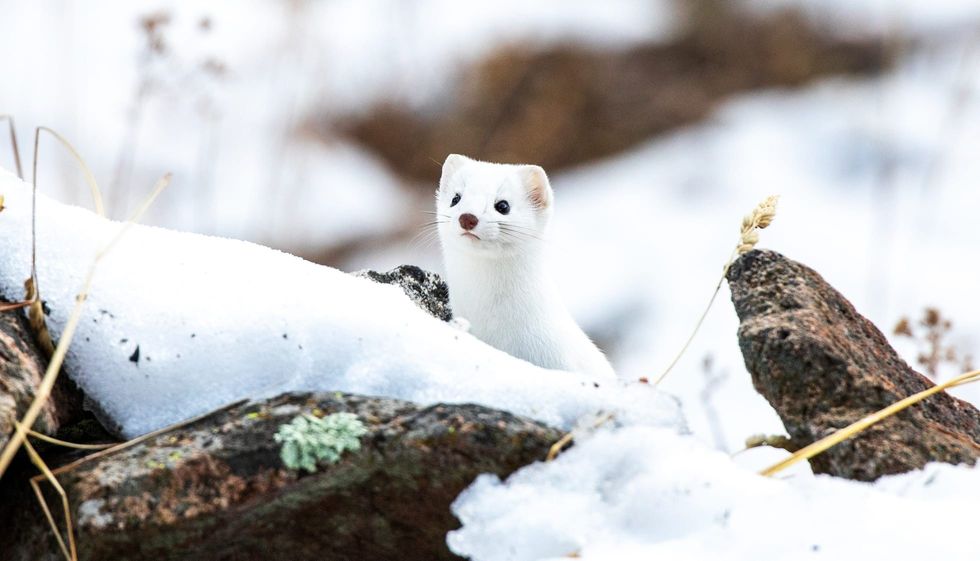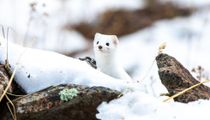The stoat or short-tailed weasel (Mustela erminea) is found in areas of Eurasia and northern portions of North America and therefore is also called the European ermine, or just ermine. Stoats can be found almost all over the world except in the Great plains.
They experience seasonal molting, which gives them different colors of fur depending on the seasons. These weasel-shaped species are agile and can prey on animals bigger than them.
The ermine's light agile body allows it to move swiftly both underground and above ground. The adult male stoat dominates females and young. The female ermine tends to remain in their birthplace throughout their lives while the male ermine moves around and takes over areas that the females stay in.
Scroll down to read about the Stoat winter coat life span, what they feed on, their habitat, and other exciting details! If you want to discover more like the stoat, take a look at Stoat facts and Russian bear dog facts.
Stoat Winter Coat Interesting Facts
What type of animal is a stoat winter coat?
The stoat or the short-tailed weasel belongs to the family Mustelidae, which has all the carnivorous mammals.
What class of animal does a stoat winter coat belong to?
It belongs to the Mammalia class and its phylum is Chordata.
How many stoat winter coats are there in the world?
Even though there isn't an exact assessment of the number of short-tailed weasels in the world at present, the conservation status clearly depicts that there are enough stoats in the world and the species is not endangered.
Where does a stoat winter coat live?
The stoat can be found in areas where there are woodlands, marshes, shrubby areas, and open areas near forests or shrub borders. Although these species are primarily terrestrial, they climb trees and swim well.
Several tree roots, hollow logs, stone walls, and rodent burrows are used as dens and they line their nests with dry vegetation, fur, and feathers from their prey. The side cavities of the burrows are used as food storage places and latrines.
What is a stoat winter coat's habitat?
Stoats can be found almost all over the world. They are found in the north temperate regions of Eurasia and North America. This species is also found from the Arctic Ocean and adjacent islands of the Canadian Archipelago going southward into the Northern United States.
Who does stoat winter coat live with?
The Mustela erminea (white winter coat) is a solitary animal. The male and female species inhabit different territories and during the season of mating, the male stoat travels to the female.
How long does a stoat winter coat live?
The average life span of the white winter coat species is about two to nine years.
How do they reproduce?
Ermine is an extremely polygamous mammal and mate with one another at any opportunity during the mating season. The breeding starts during the late spring to early summer. After mating, the female stoat goes through an embryo stoppage, which means the embryo doesn't immediately implant in the uterus but stays dormant for almost 9-10 months.
The gestation period lasts for almost 280-300 days and the litter size ranges from 3-18 offsprings. The male stoat plays no role in rearing the young ones and leaves almost immediately after the babies are born.
The young ones are born blind, deaf and toothless and are covered in pinkish fur. By the third week, there are brown specks on the newborn.
The milk teeth also come out after three weeks and they are able to feed on solid food by the fourth week. The young ones grow quickly and by the eighth week, they are able to hunt with their mothers.
Although the female species doesn't grow fully by the eighth week, they can start mating. The male stoat on the other hand doesn't mate till the next summer.
What is their conservation status?
According to the IUCN Red List, the Mustela erminea is on the Least Concern list. This species is found in abundance almost all over the world.
Stoat Winter Coat Fun Facts
What do stoat winter coat look like?
The ermine species looks like a weasel with its long body and short legs. They have a long neck with a triangular head that slightly protrudes around the ears.
Their facial features include bright black eyes and long whiskers. The male ermine is twice the size of the female. They have a black tip at the end of the tail, and the tail along with the tail tip itself makes up most of the body length of the ermine.
The eyes of the ermine are round and protrude slightly. The stoat molts twice a year and has chestnut-brown sandy rough fur during the summers while it has white silky fur during the winters.
This only happens in stoats that inhabit the northern hemisphere. Stoats that stay in the southern hemisphere don't molt their fur so much. During the summer they have brown fur with a black tail tip and it becomes pale white during the winter.

How cute are they?
With their wiggly bodies, the white stoat's presence can bring joy, but it can't be forgotten that they are swift predators that can kill animals twice their size.
How do they communicate?
White stoats are notoriously vicious animals but their way of communicating is surprisingly gentle. They make sounds like chirruping guinea pigs or soft bird chatter.
How big is a stoat winter coat?
The length of the ermine's body is almost 8.34-17.71 in (21.2-45 cm) and its tail adds to its height and makes them almost 6.69-12.99 in (17-33 cm) tall.
How fast can a stoat winter coat run?
There isn't an exact mention of the white stoat's speed but the white stoats are quite fast runners as they are superb predators, but even then they can be tackled by bigger predators like the Red fox, martens, badgers, and so on.
How much does a stoat winter coat weigh?
These stoats can weigh almost 0.88-4.09 oz (25-116 g). The stoat's weasel-like body makes it quite flexible and they don't weigh much because they have to move around a lot in order to hunt.
What are the male and female names of the species?
Even though the male and female ermine are quite different from each other in size, there are no specific names assigned to them.
What would you call a baby stoat winter coat?
There are no specific names assigned to the baby stoats and are called young or just newborn stoats or ermine.
What do they eat?
The ermine is a carnivorous predator and primarily hunts for its food at night. Unlike weasels that feed on small rabbits, the ermine feeds on larger rodents and Field voles.
Russian stouts feed on the European water vole, common hamsters, and pikas. They also feed on small birds, fish, amphibians, lizards, and insects when there is scarcity in their primary food source.
In New Zealand, stoats primarily prey on birds like Kiwi, kaka, Mohua, yellow-crowned parakeet, and New Zealand dotterel. In Great Britain, they rarely kill voles and primarily feed on muskrats.
Are they dangerous?
Being ravenous predators, the stoat winter coats are quite dangerous to humans if they can get the passage to attack them. They don't have any venom but can hurt well.
Would they make a good pet?
Keeping an ermine as a pet is quite dangerous as they are vicious predators and can attack anyone. It is also illegal to sell stoats or keep them as pets. Any weasels or related family species shouldn't be kept as pets, as they can harm children and other pets and also adults if they find the chance.
Did you know...
The white winter coat was quite valuable in earlier days and this led to humans trapping thousands of ermine each season. As the production of the snow or brown winter coat and stoles from the white or brown fur of the stoats have become illegal, they are not caught by humans anymore.
How does a white coat help a stoat survive in winter?
During the winter, the stoat's surroundings are snow white and if it has brown fur as it has during the summer, it would stand out while preying and also get preyed on way more. The white fur enables it to camouflage itself better in the snow.
How many babies do stoat winter coats have?
After mating, the female stoat goes through embryonic diapause, which means the embryo doesn't immediately implant in the uterus but stays dormant for almost 9-10 months. The gestation period lasts for almost 280-300 days and the litter size ranges from 3-18 offsprings with an average of 4-10 at a time.
Here at Kidadl, we have carefully created lots of interesting family-friendly animal facts for everyone to discover! For more relatable content, check out these Pampas cat fun facts and Weasel Facts for Kids.
You can even occupy yourself at home by coloring in one of our free printable Mammals coloring pages.
*The second image was taken by Sasha Sanbith.









